 Image search results - "castle" Image search results - "castle" |
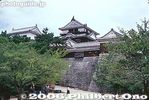
Matsuyama Castle
|
|
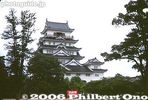
Fukuyama Castle tower
|
|

Okazaki Castle towerThe castle was dismantled during the Meiji Period and the area was made into a castle park. The castle tower was later rebuilt in 1959.
|
|
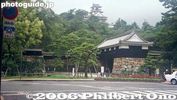
Yamauchi Kazutoyo's castle. My Contax compact film camera had a bad lens day, making the images foggy.
|
|

Uwajima Castle tower (Important Cultural Property), Ehime Prefecture.
|
|
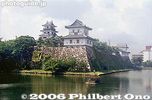
Originally built in 1604 by Lord Takatora Todo, Imabari Castle today is still a very good castle complex with great views of the city and Inland Sea. The castle tower was reconstructed in 1980. 今治城Unfortunately, my camera lens had a fogging problem.
|
|

Occupying a huge plot of land in the center of the city, Kanazawa Castle has undergone extensive renovations and reconstruction. The main castle buildings are now magnificently restored.
|
|
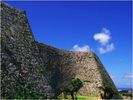
Nakagusuku Castle is part of a World Heritage Site of Okinawan gusuku castles. This is a view looking eastward from the base of the 3d enclosure (migusuku). Photos in this album all by Michael Lynch. Constructed in mid-fourteenth century of limestone rocks, placed without the use of mortar, Commodore Perry praised the construction technique on his visit to Okinawa in 1853.
|
|

Map of Kanazawa Castle Park and Kenrokuen Garden
|
|

Very little remains of Otowa castle originally built by Lord Gamou Sadahide. Two battles took place here in 1496 and 1503. Road to Otowa Castle on the hill seen on the left.
|
|
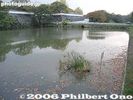
Castle moat
|
|
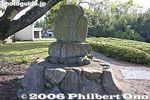
Nakano Castle, also known as Hino Castle, built in 1534 by Lord Gamou Sadahide (1508-1579). In 1582, when Oda Nobunaga was assassinated in Kyoto, Lord Gamo Katahide brought Nobunaga's wife and children from Azuchi Castle to Hino Castle for their safe
|
|

Kameyama Castle is now headquarters to a religion called Omoto-kyo which acquired the castle property in 1919. Only stone walls and moats remain.Statue of shachihoko.
|
|
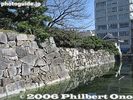
Higo Moat and turret (?)This is near the Karatsu City Hall. From Karatsu Station, it takes about 25 min. to walk to the castle tower.
肥後堀
|
|

Kakegawa Castle as seen from the train
|
|

Road to Himeji Castle. From Himeji Station, the main road leads to the castle which can be seen in the distance.
|
|

Nijo-jo castle was built on the order of Tokugawa Ieyasu to serve as the Kyoto residence for the Tokugawa shoguns. Although it does not have a castle tower, Nijo-jo Castle is Japan's best preserved and most magnificent castle palace.Seinan-sumi (Southwest corner) Turret is the first castle building you see when you walk from the station. Important Cultural Property 西南隅櫓
|
|

Akashi Castle seen from the train platform of Akashi Station.
|
|

Road to Inuyama Castle
|
|

A symbol of Osaka and one of Japan's largest reconstructed castles. Originally built by Toyotomi Hideyoshi in 1583. The castle tower was reconstructed in 1931 and underwent major renovation during 1995-97 and serves as a very modern history museum. Closest station is Osaka-jo Koen Station.
|
|

Maruoka Castle is Japan's oldest surviving castle tower although it collapsed during the Fukui Earthquake in 1948. Rebuilt in 1955 with most of the original materials. Originally built in 1576 by Shibata Katsutoyo, nicknamed Kasumiga-jo (Misty CastlePhoto: Way to Maruoka Castle from the bus stop.
|
|

Bridge to castle grounds. 5-min. walk from Fukui Station.
|
|

Toyama Castle 富山城
|
|

Chiba Castle as seen from Kencho-mae monorail station.
|
|

Entrance to Honmaru Goten palace, Kawagoe Castle.
|
|

Entrance to castle tower
|
|

Fukuyama Castle tower
|
|
|

Near the castle gate
|
|

Castle tower
|
|
|

Kanazawa Castle was the base for the Kaga Domain (Ishikawa and Toyama Prefectures) ruled by the Maeda clan 1583–1871 starting with Maeda Toshiie.
|
|

World Heritage Marker. Photo copyright 2009 Michael Lynch.
|
|

Entrance to Inohana Park
|
|

Ninomaru Northern Stone wall along a moat. 二の丸北面石垣
|
|
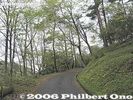
The castle is somewhat out of the way. It's a 15-min. walk from the nearest bus stop.
|
|
|
|

The castle was abandoned in 1597. Only a few stone walls and shrines remain adjacent to Hinokawa Dam. This is one entrance to Nakano Castle. Map
|
|
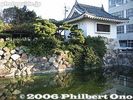
Turret (?)
|
|

Kameyama Castle was built by Akechi Mitsuhide in the 16th century as his base for his conquered Tanba region.
|
|

Yotsuashi-mon GateMain gate to enter the castle grounds. A reconstruction.
四足門
|
|

Road to Himeji Castle. Otemae Boulevard (Symbol Road). 大手前通り
|
|
|

Akashi Castle seen from the train platform of Akashi Station.
|
|

Kiso River with Inuyama Castle in the distance
|
|

The original Osaka Castle built by Toyotomi Hideyoshi was actually buried (smothered) by the Tokugawa and a new castle was built on it. Aoya-mon Gate 青屋門. Rebuilt in 1970.
|
|

Entrance to castle grounds
|
|

Bridge to castle grounds with prefectural capital building looming ahead.
|
|
|
|
|
|
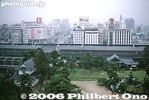
View from castle tower
|
|
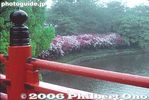
Bridge and azaleas
|
|
|
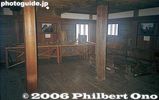
Inside Uwajima Castle tower.
|
|
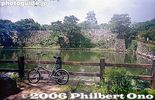
My bicycle
|
|
|
|
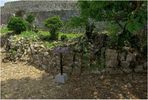
Sacred Site. There are eight special places of worship (Utaki) located within the castle walls. This view looks toward the East from the inside of the 1st enclosure. Photo copyright 2009 Michael Lynch.
|
|

Path to Chiba Castle (visible on left)
|
|

Shinmaru Park 新丸広場
|
|
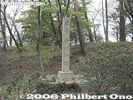
The castle met its demise in 1522 less than 60 years after it was built, after a war within the Gamou Clan. It now serves as a large hilltop park with good views of the surroundings. Otowa Castle marker
|
|
|

Path to Nakano Castle ruins
|
|

The turret turned out to be a public toilet...Looked nice enough to photograph, but when I walked around it, it smelled like the toilet it was.
|
|

Statue of shachihoko roof ornament
|
|

Steps to the castle tower
|
|

Uchibori Inner Moat
|
|

Minami-mon (South) Gate 南門
|
|

Inuyama Castle
|
|

Aoya-mon GateRebuilt in 1970. Although this is not the main or front gate, it is the closest castle gate to Osaka-jo Koen Station.
青屋門
|
|

The stone marker says National Treasure Kasumiga-jo Castle.The castle was a National Treasure until it collapsed in the 1948 Fukui Earthquake. Now an Important Cultural Property.
|
|
|

Reconstructed in 1954, modeled after Hikone and Inuyama Castles. Renovated in Nov. 2005.
|
|

Garden
|
|
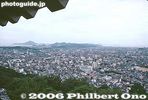
View from top floor
|
|
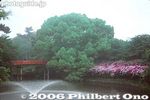
Azaleas
|
|
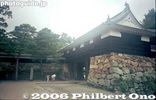
Castle gate
|
|
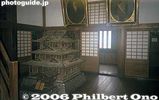
Inside castle tower
|
|
|
|
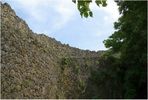
A view from the base of the West enclosure. Constructed in mid-fourteenth century of limestone rocks, placed without the use of mortar, Commodore Perry praised the construction technique on his visit to Okinawa in 1853. Photo copyright 2009 Michael Lynch.
|
|

Chiba Castle and paper lanterns
|
|

Dobashi-mon Gate stone walls 土橋門石垣
|
|

Suzuka Quasi-National Park markerThe area is within this park.
|
|
|
|
|

Higo Moat
|
|
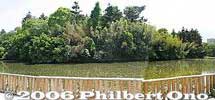
Castle compound and moat
|
|

Fukuyama Castle from the train
|
|
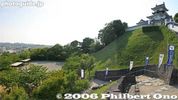
Castle tower
|
|

Castle moat
|
|

Castle moat
|
|

Tonan-sumi (Southeast corner) Turret, Important Cultural Property 東南隅櫓
|
|

Inuyama Castle
|
|
|

Maruoka Castle tower
|
|

Statue of castle founder and 1st lord, Yuki Hideyasu 結城秀康
|
|
|
|

View from top floor
|
|
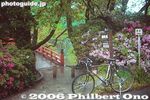
Bridge to caslte
|
|
|

View from top floor
|
|
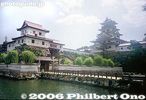
Imabari Castle 今治城
|
|

Highway in front of the castle.
|
|

Rear Gate. Most visitors will enter through this gate to the castle, as it is closest to the parking and ticket sales. Photo copyright 2009 Michael Lynch.
|
|

Chiba Castle Sakura Matsuri lantern
|
|

Dobashi-mon Gate stone wall 土橋門石垣
|
|

Entrance to castle grounds, now a picnic and playground.
|
|
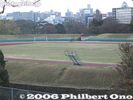
Heiwadai Track and Field arena
|
|

Nakano (Hino Castle) in Hino, Shiga Pref. The castle was built in 1534 by Lord Gamou Sadahide (1508-1579).
|
|
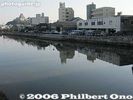
River and castle in the distance
|
|

Castle moat
|
|
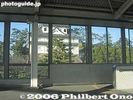
Fukuyama Station (shinkansen)
|
|

Stairs to Kakegawa Castle tower
|
|

Path to Otemon Gate, the main gate to the castle. 大手門
|
|

Entrance to Akashi Park
|
|

Tonan-sumi (Southeast corner) Turret 東南隅櫓
|
|

Haritsuna Shrine
|
|

Inner moat
|
|

Maruoka Castle tower
|
|

Valley between the prefectural capital (left) and police department (right).
|
|

Toyama Castle
|
|
|
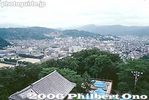
View from top floor
|
|
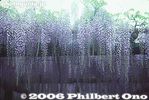
Wisteria
|
|
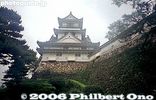
Kochi Castle tower
|
|
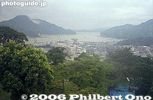
View from top floor
|
|
|
|

Outer castle wall
|
|
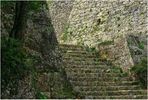
Stone Stairs. They lead to the 2nd enclosure. Visitors should wear sturdy walking shoes, as the stone-lined pathways and stairs can be very difficult to walk on without twisting an ankle. Photo copyright 2009 Michael Lynch.
|
|

Chiba Castle tower
|
|

Dobashi-mon Gate stone wall. Notice the hexagonal stones. 土橋門石垣
|
|

Castle monument
|
|
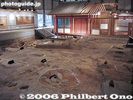
Korokan ruinsThe Korokan was a Heian-Period guest house for foreign dignitaries and diplomats.
鴻臚館跡
|
|
|

Bridge to castle城内橋
|
|
|
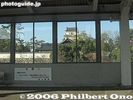
Fukuyama Station (shinkansen)
|
|
|

Otemon Gate, Main gate to castle. Reconstructed in 1937. 大手門
|
|

Castle moat
|
|

Tonan-sumi (Southeast corner) Turret 東南隅櫓
|
|

Sanko Inari ShrineThe shrine provides a short cut to the castle.
|
|
|
|

Maruoka Castle tower
|
|

Stone foundation of the castle tower at one corner.
|
|
|
|
|

Kochi Castle tower
|
|
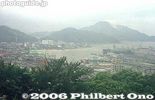
View of Uwajima city from top floor
|
|
|
|
|
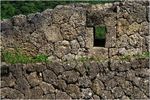
Gun Port. At several locations along the North walls of the castle, gun ports may be seen, where sentries could repel invaders. Photo copyright 2009 Michael Lynch.Many visitors are surprised to learn that firearms were in existence in the 14th century.
|
|

Chiba Castle
|
|

Gate to Former Brigade Office 切手門
|
|

Hilltop left
|
|
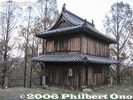
Fukuoka Castle, Kinen Turret祈念櫓
|
|

In 1582, when Oda Nobunaga was assassinated in Kyoto, Lord Gamo Katahide brought Nobunaga's wife and children from Azuchi Castle to Hino Castle for their safety. The castle was abandoned in 1597.
|
|

Jonai Bridge to castle城内橋
|
|

Entrance to Omoto-kyo HQ and former castle grounds
|
|
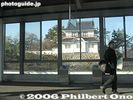
Fukuyama Station (shinkansen)
|
|

Final gate to Castle tower
|
|

World Heritage Site marker. 世界遺産 姫路城
|
|

Twin turrets of Akashi Castle
|
|

Tonan-sumi (Southeast corner) Turret 東南隅櫓
|
|

Steps to castle gate
|
|

In 2006, a rare folding screen painting showing Osaka Castle during Hideyoshi's years in early 17th century was found at Schloss Eggenberg Castle in Austria.http://www.museum-joanneum.at/en/schloss_eggenberg/saka-zu-bybu-1
|
|
|
|

Stairs to castle tower foundation
|
|
|

Veranda facing a garden.
|
|
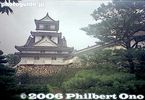
Kochi Castle tower
|
|
|

Castle tower entranceThe castle tower is a local history museum.
|
|

Ishikawa Bridge to Ishikawa-mon Gate
|
|
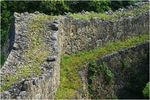
Terraced Walls. A view looking from north to south standing at an elevated point along the inner castle walls. Photo copyright 2009 Michael Lynch.
|
|
|

Former Brigade Office (closed to public) 旧第六旅団司令部
|
|

Otowa Castle's hilltop center, now a playground.In Hino, Shiga Pref.
|
|
|
|
|
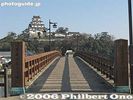
Jonai Bridge to castle城内橋
|
|
|

Fukuyama Station (shinkansen)
|
|

View of castle palace
|
|

World Heritage Site marker. 世界遺産 姫路城
|
|

Twin turrets of Akashi CastleThe left turret is called the Hitsujisaru Turret (坤櫓) and the right one is called the Tatsumi Turret (巽櫓).
|
|

Tonan-sumi (Southeast corner) Turret 東南隅櫓
|
|

Steps to castle gate
|
|

Gokuraku-bashi BridgeMeans Paradise Bridge. The original bridge was wooden. Rebuilt in 1965. It connects the Yamazato-maru section with the Ninomaru section.
極楽橋
|
|

Path to castle tower
|
|

Atop the castle tower foundation (lower level)
|
|
|
|
|
|
|
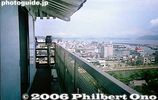
Top floor balcony
|
|

Ishikawa-mon Gate 石川門
|
|

Three Sacred Sites. The South enclosure contains three Utaki (sacred sites), all within a small area, as seen by the signs in this picture. Many Okinawans come to worship at these Utaki and make offerings. Photo copyright 2009 Michael Lynch.From the high ground to the left of this scene, you may be able to see Kudaka-Jima, where locals believe the first Okinawans originated.
|
|

Sukiyashiki stone wall. Some markings are engraved on the stones. 数寄屋敷石垣
|
|

Hilltop right
|
|
|
|

Jonai Bridge to Karatsu Castle城内橋
|
|
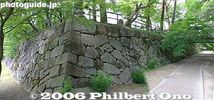
Stone foundation
|
|

View of Honmaru
|
|

San no Maru. This area is ringed by cherry trees. 三の丸広場
|
|

Hitsujisaru Turret (坤櫓)
|
|
|

Reconstructed Honmaru Gate
|
|

Gokuraku-bashi Bridge
|
|

Maruoka Castle
|
|

Monuments
|
|
|

Cherry blossoms and Chiba Castle
|
|

Hill where the Fujimi Turret once stood.
|
|

Castle tower
|
|

At 271 meters high, Mt.Hachiman-yama was the site of Hachiman Castle built by Toyotomi Hidetsugu in 1585. Now home to Zuiryuji temple of the Nichiren Sect, some of the castle's stone walls still remain. MAP
|
|
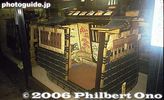
Inside castle tower a palanquin
|
|
|
|
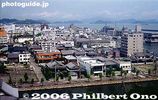
View from top floor
|
|

Passing through Ishikawa-mon Gate 石川門
|
|
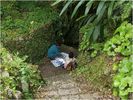
Sacred Well. There are three spring-fed wells within the castle. This one is located in the West enclosure and is also a sacred site where people make ritual offerings. Photo copyright 2009 Michael Lynch.The woman on the left gave consent to take a photo after helping her down the rough, stone stairs.
|
|

Gokuraku-bashi Bridge 極楽橋
|
|
|

Castle tower foundation天守台
|
|

Torii and steps to Inari Shrine
|
|
|
|
|

Inside Castle tower
|
|

Special Historical Place marker
|
|

Path to turrets
|
|
|

Inuyama Castle tower
|
|

Gokuraku-bashi Bridge
|
|
|
|

The castle tower suffered a major fire in 1669, and it was never rebuilt.
|
|
|

Former castle moat.
|
|
|
|

Inside castle tower
|
|
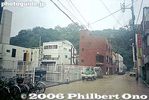
Uwajima Castle on the hill
|
|
|
|
|
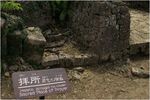
Utaki. A closeup view of a place of worship. Incense is sometimes burned and coins placed in the stone container centered within the utaki stone walls. Photo copyright 2009 Michael Lynch.
|
|

Stone walls seen from Gokuraku-bashi Bridge.
|
|

Trench or moat
|
|
|
|
|
|
|
| 4975 files on 20 page(s) |
1 |
 |
 |
 |
 |
|